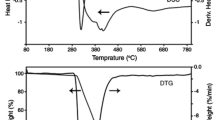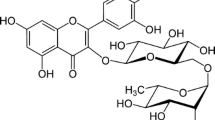Abstract
In this work, we investigated the influence of β-cyclodextrin on the photostability of tretinoin and compared the photo-chemical stability of tretinoin, either in methanol or complexed with β-cyclodextrin, when exposed both to UV and fluorescent light. The physico-chemical characterization of tretinoin-β-cyclodextrin complexes, prepared by the freeze-drying process, using different tretinoin:β-cyclodextrin molar ratios (1:1 and 1:3), was carried out in solution by phase solubility studies, 1H-NMR spectroscopy, and in solid state by infrared spectroscopy (FT-IR); these analyses confirmed the existence of an inclusion compound. Solubility study results showed that tretinoin solubility was enhanced by inclusion in β-cyclodextrin as a function of increasing concentrations of β-cyclodextrin in aqueous solution at different pH values (i.e., 3.0, 5.5, and 7.0). Moreover, the complexation of the tretinoin with β-cyclodextrin effectively protected the photolabile drug and reduced the degradation of tretinoin induced by UV and fluorescent light, improving its photo-chemical stability in comparison with free drug in methanol. Indeed, dissolved tretinoin in methanol degraded very quickly and completely, while β-cyclodextrin-included tretinoin decomposition was delayed and, after 30 days under UV exposure, the percentage of remaining drug was about 20–25% (depending on the tretinoin concentration). The photodegradation of tretinoin in methanol under fluorescent light was slower: after 5 days of irradiation it reached a photostationary state and intact tretinoin remained constant (6.6%). In conclusion, the β-cyclodextrin complexation always led to a reduction of degradation, depending on the tretinoin:β-cyclodextrin molar ratio and on the drug concentration (0.2 mg/ml or 0.4 mg/ml).





Similar content being viewed by others
References
Mandy, S.A., Thorne, E.G.: A comparison of the efficacy and safety of tretinoin cream 0.025% and 0.05%. Adv. Ther. 7, 94–99 (1990).
Elias, P.M.: Epidermal effects of retinoids. Supramolecular observations and clinical implications. J. Am. Acad. Dermatol. 15, 797–809 (1986).
Elbaum, D.J.: Comparison of the stability of topical isotretinoin and topical tretinoin and their efficacy in acne. J. Am. Acad. Dermatol. 19, 486–491 (1988).
Motto, M.G., Facchine, K.L., Hamburg, P.F., Burinsky, D.J., Dunphy, R., Oyler, A.R., Cotter, M.L.: Separation and identification of retinoic acid photoisomers. J. Chromatogr. 481, 255–262 (1989).
Connors, K., Amidon, G., Kennon, L.: Chemical Stability of Pharmaceuticals. John Wiley and Sons, New York (1979).
Carstensen, J.: Drug Stability: Principles and Practices, Marcel Dekker, New York (1990).
Deflandre, A., Lang, G.: Photostability assessment of sunscreens. Benzylidene camphor and dibenzoylmethane derivatives. Int. J. Cosmet. Sci. 10, 53–62 (1988).
Dromgoole, S.H., Maibach, H.I.: Sunscreening agent intolerance: contact and photocontact sensitization and contact urticaria. J. Am. Acad. Dermatol. 22, 1068–1078 (1990).
Manconi, M., Sinico, C., Valenti, D., Loy, G., Fadda, A.M.: Niosomes as carriers for tretinoin I. Preparation and properties. Int. J. Pharm. 234, 237–248 (2002).
Manconi, M., Sinico, C., Valenti, D., Loy, G., Fadda, A.M.: Niosomes as carriers for tretinoin II. Influence of vesicular incorporation on tretinoin photostability. Int. J. Pharm. 260, 261–272 (2003).
Loukas, Y.L., Jayasekera, P., Gregoriadis, G.: Characterization and photoprotection studies of a model γ-cyclodextrin-included photolabile drug entrapped in liposomes incorporating light absorbers. J. Phys. Chem. 99, 11035–11040 (1995).
Loftsson, T., Brewster, M.E.: Pharmaceutical applications of cyclodextrins. 1. Drug solubilazation and stabilization. J. Pharm. Sci. 85, 1017–1025 (1996).
Andersen, F., Bundgaard, H.: Inclusion complexation of metronidazole benzoate with β-cyclodextrin and its depression of anhydrate-hydrate transition in aqueous suspensions. Int. J.Pharm. 19, 189–197 (1984).
Loukas, Y.L., Vraka, V., Gregoriadis, G.: Fluorimetric studies of the formation of riboflavin-β-cyclodextrin inclusion complex: determination of the stability constant by use of a non-linear leastsquares model. J. Pharm. Pharmacol. 49, 127–130 (1997).
Nalluri, B.N., Chowdary, K.P.R., Murthy, K.V.R., Hayman, A.R., Becket, G.: Physicochemical characterization and dissolution properties of nimesulide-cyclodextrin binary systems. AAPS Pharm. Sci. Tech. 4(1), E2 (2003).
Scalia, S., Casolari, A., Iaconinoto, A., Simeoni, S.: Comparative studies of the influence of cyclodextrins on the stability of the sunscreen agent, 2-ethylhexyl-p-methoxycinnamate. J. Pharm. Biomed. Anal. 30, 1181– (2002).
Mukne, P., Nagarsenker, M.S.: Triamterene-β-cyclodextrin systems: preparation, characterization and in vivo evaluation. AAPS Pharm. Sci. Tech. 5(1), article 19, E19 (2004).
Duchêne, D., Wouessidjewe, D.: Pharmaceutical uses of cyclodextrins and derivatives. Drug Dev. Ind. Pharm. 16, 2487–2499 (1990).
Frömming, K.H., Szejtli, J.: Cyclodextrins in Pharmacy, Topics in Inclusion Science, Kluwer, Dordrecht (1994).
Anadolou, R.Y., Sen, T., Tarimci, N., Birol, A., Erdem, C.: Improved efficacy and tolerability of retinoic acid in acne vulgaris: a new topical formulation with cyclodextrin complex ψ. J. Eur. Acad. Dermatol. Venereol. 18, 416–421 (2004).
Dollo, A.G., Le Corre, P., Chevanne, F., Le Verge, R.: Inclusion complexation of amide-typed local anaesthetics with beta-cyclodextrins and its derivatives. Int. J. Pharm. 131, 219–228 (1996).
Barbato, F., Cappello, B., La Rotonda, M.I., Miro, A., Quaglia, F.: Diclofenac β-cyclodextrin binary systems: a study in solution and in the solid state. J. Incl. Phenom. 46, 179–185 (2003).
Higuchi, T., Connors, K.A.: Phase-solubility techniques. Adv. Anal. Chem. Instrum. 4, 117–212 (1965).
Montassier, P., Duchêne, D., Poelman, M.C.: Inclusion complexes of tretinoin with cyclodextrins. Int. J. Pharm. 153, 199–209 (1997).
Djedaini, F., Lin, S.Z., Perly, B.: Nuclear magnetic resonance of cyclodextrins, derivatives and inclusion compounds. In: Duchêne, D (ed.) New trends in Cyclodextrin and Derivatives, pp. 217–246. Editions de Santè, Paris, (1991).
Pose-Vilarnovo, B., Perdomo-Lòpez, I., Echezarreta-Lopez, M., Schroth-Pardo, P., Estrada, E., Torres-Labandeira, J.J.: Eur. J. Pharm. Sci. 13, 325–331 (2001).
Ficarra, R., Ficarra, P., Di Bella, M.R., Raneri, D., Tommasini, S., Calabro, M.L., Gamberini, M.C., Rustichelli, C.: Study of beta-blockers/beta-cyclodextrins inclusion complex by NMR, DSC, X-ray and SEM investigation.. J. Pharm. Biomed. Anal. 23, 33–40 (2000).
Manca, M.L., Zaru, M., Ennas, G., Valenti, D., Sinico, C., Loy, G., Fadda, A.M.: Diclofenac-β-cyclodextrin binary systems: physicochemical characterization and in vitro dissolution and diffusion studies. AAPS Pharm. Sci. Tech. 6(3), E464 (2005).
Noy, N.: The ionization behavior of retinoic acid in aqueous enviroments and bound to serum albumin. Biochim. Biophys. Acta. Biomembr. 1106(1), 151–158 (1992).
Guo, Q.-X., Ren, T., Fang, Y.P., Liu, Y.-C.: Binding of vitamin A by β-cyclodextrin and heptakis(2,6-O-dimethyl)-β-cyclodextrin. J. Incl. Phenom. Molec. Recogn. Chem. 22, 251–256 (1995).
Author information
Authors and Affiliations
Corresponding author
Rights and permissions
About this article
Cite this article
Caddeo, C., Manconi, M., Valenti, D. et al. Photostability and solubility improvement of β-cyclodextrin-included tretinoin. J Incl Phenom Macrocycl Chem 59, 293–300 (2007). https://doi.org/10.1007/s10847-007-9326-z
Received:
Accepted:
Published:
Issue Date:
DOI: https://doi.org/10.1007/s10847-007-9326-z




